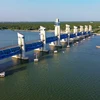Can Tho (VNA) - The most severe saline intrusion - the movement of ocean saltwater into riverine freshwater - is said to occur in the Mekong Delta region from February 8 to 16, coinciding with the Tet (Lunar New Year) holiday, since Chinese hydro-power plants have reduced their water discharge, which affects water flows downstream on the Mekong River, experts have said.
From January 5 to 24, the Jinhong Hydropower Station in China’s Yunnan province reduced its water discharge to some 1,000 cu.m per second to ensure safety for its power grid. Discharge has remained low.
Ky Quang Vinh, a former official at Can Tho city’s climate change bureau, said climate change will be the main cause of saltwater intrusion in the Mekong Delta in 2021. Low rainfall last year made it hard for upstream countries to store water let alone lower regions like the Mekong Delta.
Meanwhile, a representative from the Ministry of Agriculture and Rural Development said water resources during the 2020-2021 dry season will be low and the worst saline intrusion in history has been predicted.
Chinese hydropower plants’ cutting their water discharge in January will make the salinity depth increase to 4g/l in the mouth of the Mekong Delta’s Vam Co River and Cai Lon River, the representative said.
According to the Southern Institute of Water Resources Research, water storage in Tonle Sap and water flows to Cambodia’s Kratie province are key drivers of saline intrusion in the Delta. Water levels in Tonle Sap and Kratie stations are, however, said to be lower than in previous years.
It recommended Mekong Delta localities pay due attention to saline intrusion prevention measures, such as the rational operation of irrigation works and reductions in drainage, saying water storage should be completed before February 7 as this will help reduce damage when salinity levels increase during Tet.
In response to saline intrusion, Vinh Long province plans to spend more than 1.65 trillion VND (71.59 million USD) on supporting local production during the 2020-2021 dry season. It has asked the Ministry of Agriculture and Rural Development to provide more than 1.57 trillion VND to dredge up canals so as to create water sources for local irrigation.
Meanwhile, relevant authorities in Hau Giang province are working to keep close watch on saline intrusion before, during, and after Tet, identify timely measures to support households who experience water shortages, and provide local people with sufficient information so they can respond appropriately.
Tien Giang province, which was hit hard by saline intrusion in 2020, decided to build eight dams on local canals as a preventive measure. The move aims to ensure water for 120,250 ha of agricultural land and 1.1 million residents in Tien Giang and Long An provinces. Construction of the dams will be completed before Tet./.
From January 5 to 24, the Jinhong Hydropower Station in China’s Yunnan province reduced its water discharge to some 1,000 cu.m per second to ensure safety for its power grid. Discharge has remained low.
Ky Quang Vinh, a former official at Can Tho city’s climate change bureau, said climate change will be the main cause of saltwater intrusion in the Mekong Delta in 2021. Low rainfall last year made it hard for upstream countries to store water let alone lower regions like the Mekong Delta.
Meanwhile, a representative from the Ministry of Agriculture and Rural Development said water resources during the 2020-2021 dry season will be low and the worst saline intrusion in history has been predicted.
Chinese hydropower plants’ cutting their water discharge in January will make the salinity depth increase to 4g/l in the mouth of the Mekong Delta’s Vam Co River and Cai Lon River, the representative said.
According to the Southern Institute of Water Resources Research, water storage in Tonle Sap and water flows to Cambodia’s Kratie province are key drivers of saline intrusion in the Delta. Water levels in Tonle Sap and Kratie stations are, however, said to be lower than in previous years.
It recommended Mekong Delta localities pay due attention to saline intrusion prevention measures, such as the rational operation of irrigation works and reductions in drainage, saying water storage should be completed before February 7 as this will help reduce damage when salinity levels increase during Tet.
In response to saline intrusion, Vinh Long province plans to spend more than 1.65 trillion VND (71.59 million USD) on supporting local production during the 2020-2021 dry season. It has asked the Ministry of Agriculture and Rural Development to provide more than 1.57 trillion VND to dredge up canals so as to create water sources for local irrigation.
Meanwhile, relevant authorities in Hau Giang province are working to keep close watch on saline intrusion before, during, and after Tet, identify timely measures to support households who experience water shortages, and provide local people with sufficient information so they can respond appropriately.
Tien Giang province, which was hit hard by saline intrusion in 2020, decided to build eight dams on local canals as a preventive measure. The move aims to ensure water for 120,250 ha of agricultural land and 1.1 million residents in Tien Giang and Long An provinces. Construction of the dams will be completed before Tet./.
VNA






















